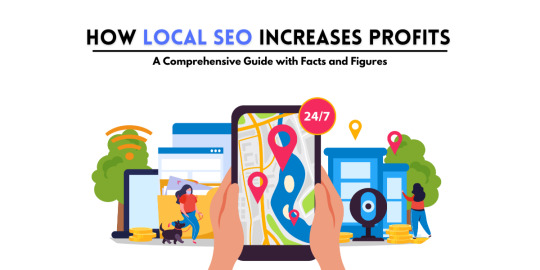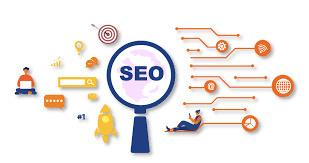#Google Analytics tips and tricks
Explore tagged Tumblr posts
Text
Google Analytics क्या है और यह कैसे काम करता है
Google Analytics एक महत्वपूर्ण और उपयोगी टूल है जो वेबसाइटों के मालिकों और डिजिटल मार्केटर्स को उनकी वेबसाइटों के बारे में गहरी जानकारी प्राप्त करने में मदद करता है। यह एक मुफ्त वेब एनालिटिक्स सेवा है, जो Google द्वारा प्रदान की गई है और इसका उपयोग वेबसाइट पर आने वाले विजिटर्स का डेटा ट्रैक करने, वेबसाइट की परफॉर्मेंस मापने, और डिजिटल मार्केटिंग रणनीतियों को बेहतर बनाने के लिए किया जाता है। आज के…
#Google Analytics audience insights#Google Analytics dashboard#Google Analytics data analysis#Google Analytics features#Google Analytics for beginners#Google Analytics for SEO#Google Analytics metrics explained#Google Analytics reporting#Google Analytics setup guide#Google Analytics tips and tricks#Google Analytics tutorial#how to use Google Analytics#understanding Google Analytics
0 notes
Text
New Business Marketing Tips And Tricks for Success
Starting a new business can be an exciting endeavor, but it also comes with its fair share of challenges, especially in the competitive landscape of today's market. Effective marketing is crucial for the success of any new venture. Here are four essential marketing tips and tricks to help your new business thrive.
Define Your Target Audience: Before diving into marketing efforts, it's essential to identify and understand your target audience. Define your ideal customer persona by considering demographics, interests, pain points, and buying behaviors. Conduct market research to gather valuable insights that will guide your marketing strategies. Tailoring your messages and campaigns to resonate with your target audience will significantly increase your chances of success.
Once you have a clear picture of your audience, choose the most suitable marketing channels to reach them effectively. Social media, email marketing, content marketing, and pay-per-click advertising are just a few options to consider. Your choice of channels should align with where your audience spends their time online.

Create Compelling Content: Content marketing is a powerful tool for new businesses to establish their brand and build credibility. Develop high-quality, informative, and engaging content that addresses the needs and interests of your target audience. This content can take various forms, including blog posts, videos, infographics, and podcasts.
Consistency is key when it comes to content creation. Develop a content calendar to plan and schedule regular updates. Providing valuable content not only helps you connect with your audience but also boosts your search engine rankings, making it easier for potential customers to find you.

Leverage Social Media: Social media platforms have become indispensable for marketing in today's digital age. Create profiles on relevant social media platforms and engage with your audience regularly. Share your content, interact with followers, and participate in industry-related discussions.
Paid advertising on social media can also be a cost-effective way to reach a broader audience. Platforms like Facebook, Instagram, and LinkedIn offer targeting options that allow you to reach users who match your ideal customer profile.

Monitor and Adapt: Marketing is an ever-evolving field, and what works today may not work tomorrow. To stay ahead of the curve, regularly monitor the performance of your marketing efforts. Analyze key metrics such as website traffic, conversion rates, and return on investment (ROI). Use tools like Google Analytics and social media insights to gather data and insights.
Based on your findings, be prepared to adapt your strategies and tactics. If a particular marketing channel isn't delivering the expected results, reallocate your resources to more promising avenues. Stay up-to-date with industry trends and keep an eye on your competitors to ensure your marketing efforts remain relevant and competitive.
In conclusion, effective marketing is essential for the success of any new business. By defining your target audience, creating compelling content, leveraging social media, and continuously monitoring and adapting your strategies, you can position your new business for growth and long-term success in a competitive market. Remember that success may not come overnight, but with persistence and the right marketing approach, your new business can thrive.

#business#digitalbusiness#digitalmarketing#seo#market analysis#data analytics#marketing#management#sales#learn digital marketing#Digital marketing course#seo expert#business success#businessgrowth
88 notes
·
View notes
Text
New Business Marketing Tips and Tricks for Success
Starting a new business can be an exhilarating adventure, but it also comes with its fair share of challenges, especially in the competitive landscape of today's marketplace. To stand out and thrive, effective marketing is crucial. Here are four essential marketing tips and tricks to help your new business succeed:
Define Your Target Audience and Create Customer Personas:
One of the first steps in crafting a successful marketing strategy for your new business is to identify and understand your target audience. Who are your ideal customers, and what are their needs, preferences, and pain points? Creating customer personas can help you visualize and humanize your audience, making it easier to tailor your marketing efforts effectively.

Start by conducting market research to gather data about your potential customers. Analyze demographics, psychographics, and behavior patterns to create detailed customer personas. These personas should include information like age, gender, income, interests, and pain points.
Once you have a clear understanding of your target audience, customize your marketing messages and strategies to resonate with them. Craft compelling content, advertisements, and promotions that address their specific needs and desires. By speaking directly to your ideal customers, you'll increase the chances of building meaningful connections and driving conversions.
Leverage the Power of Digital Marketing:
In the digital age, online presence and digital marketing are indispensable for any new business. Here are some essential digital marketing strategies to consider:
a. Build a User-Friendly Website: Your website is often the first point of contact for potential customers. Ensure that it is well-designed, easy to navigate, and mobile-responsive. Optimize it for search engines (SEO) to improve your visibility in search results.
b. Content Marketing: Create valuable and relevant content that educates, entertains, or solves problems for your target audience. Blog posts, videos, infographics, and social media updates can all be part of your content marketing strategy.

c. Social Media Marketing: Identify the social media platforms where your audience is most active and engage with them there. Develop a content calendar and use a mix of organic and paid content to reach a wider audience.
d. Email Marketing: Build and nurture an email list to stay in touch with your customers. Send personalized and relevant content, offers, and updates to keep them engaged and informed.
e. Pay-Per-Click Advertising (PPC): Consider running targeted PPC campaigns on platforms like Google Ads and Facebook Ads to reach potential customers actively searching for your products or services.
Emphasize Customer Relationships and Engagement:
In a competitive market, building and maintaining strong customer relationships is vital. Consider these strategies to enhance customer engagement:
a. Provide Exceptional Customer Service: Respond promptly to inquiries and address customer concerns with care. Happy customers are more likely to become loyal advocates for your brand.
b. Personalization: Use customer data and segmentation to personalize your marketing messages and offers. People appreciate tailored experiences that cater to their unique preferences.

c. Encourage User-Generated Content: Encourage customers to share their experiences with your products or services on social media or review platforms. User-generated content can build trust and credibility.
d. Loyalty Programs: Reward repeat customers with loyalty programs, discounts, or exclusive access to new products or services. Loyalty programs can foster long-term relationships and increase customer retention.
Monitor, Analyze, and Adapt:
Marketing is not a one-size-fits-all endeavor. To continually improve your strategies, track key performance indicators (KPIs) and adapt based on the data:
a. Use Analytics Tools: Employ tools like Google Analytics, social media insights, and email marketing metrics to monitor the performance of your marketing efforts.
b. A/B Testing: Experiment with different marketing approaches and compare their results through A/B testing. This allows you to refine your strategies over time.

c. Stay Informed: Keep up with industry trends, competitors, and evolving customer preferences. Stay open to adjusting your marketing plan as needed.
In conclusion, successful marketing for a new business involves understanding your audience, utilizing digital strategies, fostering customer relationships, and staying adaptable. By implementing these tips and tricks, your new business can navigate the competitive landscape and carve out its own path to success.
#seo#online marketing#digitalmarketing#marketing agency#learn digital marketing#digital marketing service#seo marketing#digital marketing course#digital marketing#seo expert#business success#business marketing#marketing tips
25 notes
·
View notes
Text
How Local SEO Increases Profits: A Comprehensive Guide with Facts and Figures

In today's digital landscape, businesses must leverage every tool available to stay competitive. Local SEO (Search Engine Optimization) is one of the most effective strategies for attracting customers in your geographic area. This comprehensive guide will explore how Local SEO can significantly enhance your profits, backed by facts and figures, and provide actionable tips to boost your local search presence.
What is Local SEO?
Local SEO focuses on optimizing a business's online presence to attract customers from specific localities. This includes appearing in local search results, Google Maps, and the coveted Google Local Pack.
Why is Local SEO Important?
Increased Visibility
Fact: 46% of all Google searches seek local information.
Figure: Businesses that optimize for local SEO can see a 14% increase in web traffic.
Higher Conversion Rates
Fact: 78% of mobile local searches result in an offline purchase.
Figure: Local searches contribute to 28% of all purchases.
Cost-Effective Marketing
Local SEO targets users actively seeking your services, leading to a lower cost per acquisition.
Key Components of Local SEO
1. Google My Business (GMB) Optimization
Claim and Verify Your Listing: Ensure that your GMB profile is active and verified.
Consistent Information: Keep your business name, address, and phone number (NAP) accurate across all platforms.
Engagement: Update your GMB listing with posts, photos, and promotions to engage customers.
2. Local Keywords
Keyword Research: Identify local search terms relevant to your business.
Implementation: Use these keywords in your website content, meta tags, and GMB listing.
3. On-Page SEO
Title Tags and Meta Descriptions: Optimize these elements with local keywords.
Schema Markup: Use schema to help search engines understand your business details.
4. Customer Reviews
Encouragement: Prompt satisfied customers to leave reviews on your GMB and other review platforms.
Response Strategy: Engage with all reviews—both positive and negative—to demonstrate that you value customer feedback.
5. Local Backlinks
Relationship Building: Network with local businesses and influencers to earn backlinks.
Community Engagement: Participate in local events or sponsorships to increase exposure and credibility.
Tips and Tricks to Boost Local SEO
Leverage Social Media: Share local content, promotions, and events to drive traffic and engagement.
Optimize for Mobile: Ensure your website is mobile-friendly, as a significant portion of local searches occurs on mobile devices.
Create Location-Specific Content: Develop blogs, guides, or resources that cater to local interests and events.
Use Local Citations: List your business in local directories like Yelp and Yellow Pages with consistent NAP information.
Monitor Analytics: Use Google Analytics and Google Search Console to track performance and refine your strategy.
Facts and Figures Supporting Local SEO Success
Search Engine Behavior: 88% of consumers who conduct a local search visit a related business within a day.
Consumer Trust: 92% of consumers trust online reviews as much as personal recommendations.
Mobile Searches: 76% of people who search for something nearby visit a business within a day.
Conclusion
Investing in Local SEO is essential for businesses looking to enhance their visibility and increase profits. By optimizing your online presence, focusing on local keywords, managing customer reviews, and building local backlinks, you can develop a strong local marketing strategy that drives business growth.
#Local SEO#Search Engine Optimization#Local search marketing#Google My Business#Local visibility#Local keywords#Local citations
1 note
·
View note
Text
Mastering SEO: Tips and Tricks for Online Success
In today's digital age, Search Engine Optimization (SEO) has become a cornerstone of online success. Whether you're a small business owner, a content creator, or a marketer, understanding SEO tips and tricks is essential for improving your website's visibility and driving organic traffic. In this article, we'll delve into some expert tips and tricks to help you master SEO and boost your online presence.
Keyword Research and Optimization Start by conducting thorough keyword research to identify the terms and phrases your target audience is searching for. Use tools like Google Keyword Planner, SEMrush, or Ahrefs to discover relevant keywords with decent search volumes and low competition. Incorporate these keywords strategically into your website's content, including titles, headings, meta descriptions, and throughout the body text. However, avoid keyword stuffing, as it can negatively impact user experience and lead to penalties from search engines.
Create High-Quality, Relevant Content Focus on creating valuable, engaging, and informative content that addresses your audience's needs and interests. Use a variety of content formats such as articles, videos, infographics, podcasts, and interactive elements to cater to different preferences. Regularly update your content to ensure it remains fresh and relevant, as search engines favor recent and up-to-date information.
Optimize Website Structure and Navigation Ensure your website has a clear and intuitive structure that allows both users and search engines to navigate easily. Use descriptive and SEO-friendly URLs, organize content into categories and subcategories, and implement breadcrumbs for enhanced navigation. Optimize your website's loading speed by compressing images, using caching techniques, and minimizing unnecessary scripts and plugins.
Mobile-Friendly Design With the increasing use of mobile devices, having a mobile-friendly website is crucial for SEO success. Use responsive design principles to ensure your website looks and functions seamlessly across various screen sizes and devices. Test your website's mobile-friendliness using Google's Mobile-Friendly Test tool and make necessary optimizations.
Optimize Meta Tags and Descriptions Craft compelling and descriptive meta titles and meta descriptions that accurately represent your content and entice users to click. Include relevant keywords naturally in your meta tags but avoid over-optimization. Use schema markup to provide additional context to search engines and improve the visibility of rich snippets in search results.
Earn Quality Backlinks Focus on earning high-quality backlinks from reputable and relevant websites in your industry or niche. Create shareable content that naturally attracts backlinks, such as comprehensive guides, case studies, original research, or unique insights. Participate in guest blogging, collaborate with influencers, and leverage social media platforms to amplify your content and attract backlinks organically.
Monitor and Analyze Performance Use tools like Google Analytics, Google Search Console, and third-party SEO platforms to track your website's performance, traffic sources, keyword rankings, and user behavior. Analyze data regularly to identify areas for improvement, capitalize on successful strategies, and adapt to algorithm changes and market trends.
Stay Updated and Adapt
SEO is constantly evolving, with search engines updating their algorithms and ranking factors regularly. Stay informed about industry trends, algorithm updates, and best practices through reputable SEO blogs, forums, webinars, and conferences. Continuously adapt your SEO strategies and tactics to align with current best practices and ensure long-term success.
By implementing these SEO tips and tricks, you can enhance your website's visibility, attract more organic traffic, and ultimately achieve your online goals. Remember that SEO is an ongoing process that requires dedication, monitoring, and adaptation, but the rewards in terms of improved search rankings and increased visibility are well worth the effort.
2 notes
·
View notes
Text
The best digital marketing institute in Delhi is the Premier Institute for Professional Studies (PIPS).
In order to reach a larger audience and interact with customers in ways that were previously impractical, digital marketing has become a crucial component of contemporary business strategies. Knowing where to start can be intimidating for newcomers who are just getting started in the field of digital marketing. We will go through some pointers and advice in this blog that will assist novices in navigating the world of digital marketing and developing effective campaigns.

Define Your Goals: Prior to entering the realm of digital marketing, it's critical to establish your objectives. With your digital marketing endeavors, what goals are you attempting to accomplish? Are you trying to boost sales, create leads, or raise brand awareness? You can develop a plan that will assist you in achieving your goals if you have a clear understanding of them.
Understand Your Target Audience: Being aware of your target audience is one of the most crucial parts of digital marketing. They are who? What requirements do they have? What interests do they have? It's possible to produce content that effectively engages your target audience by having a thorough understanding of them.
Create a Content Strategy: The king of digital marketing is content. To draw in and keep the interest of your target audience, you must produce high-quality, pertinent content. Create a content strategy that describes the kinds of content you will produce, the frequency at which you will release them, and the distribution channels you will use.
Utilize Social Media: Digital marketing can benefit greatly from the use of social media. It enables you to interact with consumers, reach a wide audience, and increase brand recognition. To engage with your audience and market your content, make use of social media sites like Facebook, Instagram, LinkedIn, and Twitter.
Use SEO Techniques: Success in digital marketing requires search engine optimization, or SEO. Your website's visibility in search results can be enhanced, and you can increase organic traffic to your website by optimizing its content for search engines. Make use of SEO strategies to raise your search engine rankings, such as link building, on-page optimization, and keyword research.
Monitor and Analyze Your Results: Monitoring and evaluating your progress is crucial when it comes to digital marketing. Track conversions, keep an eye on website traffic, and evaluate campaign performance with tools like Google Analytics. You can improve your digital marketing efforts by tracking your results and making necessary adjustments to determine what is and is not working.
Stay Updated on Industry Trends: The field of digital marketing is always changing as new trends and technologies appear on a regular basis. Participate in online forums, go to conferences, and follow blogs to stay up to date on news and trends in the industry. You can stay ahead of the curve and modify your digital marketing tactics in response to changes in the market by remaining informed.
Beginners can successfully navigate the world of digital marketing and create campaigns that resonate with their target audience by using these helpful tips and tricks. Take into consideration enrolling at PIPS Delhi Institute on Devli Road in New Delhi if you're interested in learning more about digital marketing. The extensive digital marketing courses offered by PIPS Delhi Institute will help you advance your career and grasp the fundamentals of the field. Come start your journey with us today and become a successful digital marketer. Call us 9870515165 to book your free trial classes today.
2 notes
·
View notes
Text
Digital Marketing Tips and Tricks
Understand your audience and your goals.
Before you start any digital marketing campaign, it's important to understand your target audience and what you want to achieve with your campaign. What are their demographics? What are their interests? What are their needs and pain points? Once you have a good understanding of your audience, you can tailor your messaging and content to resonate with them.

Create compelling content.
Content is king when it comes to digital marketing. Your content should be informative, engaging, and relevant to your target audience. It should also be well-written and edited. If you can create high-quality content that people want to read, watch, or listen to, you'll be well on your way to success.

Optimize your website for search engines (SEO).
SEO stands for search engine optimization. It's the process of optimizing your website and content so that it ranks higher in search engine results pages (SERPs). When you rank higher in SERPs, you're more likely to be seen by potential customers. There are a number of things you can do to improve your SEO, such as using relevant keywords in your titles and meta descriptions, creating high-quality content, and building backlinks to your website.

Use social media to connect with your audience.
Social media is a great way to connect with your target audience and build relationships with them. By sharing interesting and engaging content, you can attract new followers and promote your brand. You can also use social media to run contests and giveaways, and to provide customer support.

Track your results and measure your ROI.
It's important to track the results of your digital marketing campaigns so that you can see what's working and what's not. This will help you to refine your campaigns over time and improve your ROI. There are a number of different tools that you can use to track your results, such as Google Analytics and social media analytics.
Here are some additional tricks that you can use to improve your digital marketing results:
Use email marketing to stay in touch with your audience and promote your products or services. Run paid advertising campaigns on platforms such as Google Ads and Facebook Ads. Partner with other businesses in your industry to cross-promote each other's products or services. Attend industry events and conferences to network with potential customers and partners. Stay up-to-date on the latest digital marketing trends and technologies. By following these tips and tricks, you can improve your digital marketing results and achieve your business goals.

#digitalmarketing#marketing#seo#socialmediamarketing#accounting#entrepreneur#digitalmarketingtips#searchengineoptimization#onlinemarketing#marketingagency
4 notes
·
View notes
Text
Silent Marketing Tips and Tricks for Business Success

Introduction: In today's competitive business landscape, effective marketing is essential for success. While flashy advertisements and aggressive promotions can be effective, there's another, quieter approach known as "Silent Marketing" that can yield remarkable results. Silent Marketing involves subtle strategies that engage your audience without overwhelming them. In this comprehensive guide, we'll share 500 valuable Silent Marketing tips and tricks to help your business thrive.

Table of Contents:
Chapter 1: Building a Solid Foundation 1.1 Define Your Brand Identity 1.2 Identify Your Target Audience 1.3 Craft a Unique Value Proposition 1.4 Establish Clear Business Goals 1.5 Develop a Content Strategy 1.6 Optimize Your Website for Conversions 1.7 Leverage Social Proof 1.8 Understand Your Competitors 1.9 Monitor Industry Trends 1.10 Build Strong Customer Relationships

Chapter 2: Content Marketing 2.1 Create High-Quality Blog Posts 2.2 Develop Engaging Videos 2.3 Start a Podcast 2.4 Guest Post on Industry Blogs 2.5 Share User-Generated Content 2.6 Utilize Email Marketing 2.7 Write Informative Ebooks 2.8 Design Infographics 2.9 Host Webinars 2.10 Collaborate with Influencers

Chapter 3: Social Media Strategies 3.1 Choose the Right Social Platforms 3.2 Post Consistently 3.3 Use Eye-Catching Visuals 3.4 Engage with Your Audience 3.5 Run Contests and Giveaways 3.6 Share User Stories 3.7 Leverage Hashtags 3.8 Create Polls and Surveys 3.9 Showcase Behind-the-Scenes Content 3.10 Monitor Social Analytics

Chapter 4: Search Engine Optimization (SEO) 4.1 Optimize Your Website's Keywords 4.2 Create High-Quality Backlinks 4.3 Optimize for Mobile 4.4 Focus on Local SEO 4.5 Regularly Update Content 4.6 Improve Page Load Speed 4.7 Use Schema Markup 4.8 Create an XML Sitemap 4.9 Monitor Google Analytics 4.10 Invest in Voice Search Optimization

Chapter 5: Customer Engagement 5.1 Personalize Your Marketing 5.2 Listen to Customer Feedback 5.3 Offer Exceptional Customer Service 5.4 Implement Loyalty Programs 5.5 Encourage User Reviews 5.6 Provide Value Through Content 5.7 Showcase Customer Testimonials 5.8 Connect on a Human Level 5.9 Send Handwritten Notes 5.10 Surprise and Delight Your Customers

Chapter 6: Offline Strategies 6.1 Attend Industry Events 6.2 Network Effectively 6.3 Use Print Media 6.4 Collaborate with Local Businesses 6.5 Support a Cause 6.6 Sponsor Community Events 6.7 Offer Exclusive In-Person Experiences 6.8 Send Personalized Gifts 6.9 Speak at Conferences 6.10 Join Professional Organizations

Chapter 7: Measurement and Analytics 7.1 Set Key Performance Indicators (KPIs) 7.2 Use Google Analytics 7.3 Track Social Media Metrics 7.4 Monitor Email Campaigns 7.5 A/B Test Your Marketing Efforts 7.6 Analyze Conversion Rates 7.7 Study Customer Behavior 7.8 Review ROI Regularly 7.9 Adjust Your Strategies 7.10 Stay Informed About Marketing Trends

Conclusion: Silent Marketing is a powerful and strategic approach to grow your business. By implementing these 500 tips and tricks, you can create a marketing strategy that engages your audience quietly but effectively, ultimately leading to long-term success in your industry. Remember, success in marketing often comes from the combination of multiple subtle efforts, so be patient, adapt, and watch your business flourish.
#seo#digitalmarketing#digital art#seo marketing#seo services#marketing#blog#wordpress#social media#google analytics#keyword research
4 notes
·
View notes
Text

Prashant Kirad Age: Biography, Career, Net Worth, and More – A Complete Profile
In India’s rapidly growing ed-tech space, Prashant Kirad has emerged as a standout figure who bridges the gap between quality education and accessibility. As the founder of ExpHub, an online learning platform for JEE aspirants, and a YouTuber with millions of followers, Prashant is changing how students prepare for competitive exams. His success at such a young age has sparked widespread interest in his journey, especially around Prashant Kirad age, career, net worth, and inspirational rise.
Who is Prashant Kirad?
Prashant Kirad is an Indian educator, entrepreneur, and YouTube content creator best known for his JEE-focused educational channel, ExpHub. He gained fame for delivering fast-track crash courses, last-minute revision tips, and simplified learning methods. His blend of motivation, exam strategy, and visual-based teaching has made him a favorite among India's student community.
Prashant Kirad Age
As of 2025, Prashant Kirad is 28 years old. He was born on 9th December 1996 in Alwar, Rajasthan. Despite his youth, he has already made a lasting mark on India’s online education ecosystem.
Prashant Kirad Early Life
Prashant Kirad was raised in a middle-class household in the city of Alwar, Rajasthan. His upbringing emphasized values like discipline, hard work, and education. From an early age, Prashant exhibited a natural interest in science, logic, and problem-solving. His family’s support and a strong academic environment nurtured his interest in competitive exams.
He was a curious child who loved experimenting with concepts and often helped classmates with studies — a sign of the teacher he would become.
Prashant Kirad Family Background
Prashant belongs to a traditional Hindu family from Rajasthan. Though he keeps personal details about his parents and siblings private, he often acknowledges their unwavering support as a key reason behind his academic and professional success. His parents, especially, instilled a love for education and encouraged him to aim high despite challenges.
Prashant Kirad Education
Prashant completed his schooling at St. Anselm’s Senior Secondary School, Alwar, where he consistently ranked among the top students. His strong foundation in Physics, Chemistry, and Mathematics helped him clear the highly competitive JEE (Joint Entrance Examination).
He secured admission to Netaji Subhas University of Technology (NSUT), Delhi, where he pursued B.Tech in Computer Science. His engineering background played a pivotal role in shaping his analytical thinking and content development approach.
Prashant Kirad Physical Attributes
Attribute
Detail
Height
Approx. 5′7″ (170 cm)
Weight
Around 60–62 kg
Eye Color
Black
Hair Color
Black
Style
Clean and simple
His appearance is minimalistic and professional, making him easily approachable to his student audience.
Prashant Kirad Relationship
As of 2025, Prashant Kirad is unmarried and has not publicly disclosed any details regarding his romantic life. He maintains a low-profile personal life and focuses primarily on his teaching and entrepreneurial goals.
Prashant Kirad Career Journey
From Engineer to Educator
After graduating from NSUT, Prashant worked briefly in the private sector. However, his passion for education and helping students succeed led him to begin a new journey — as a digital teacher.
YouTube and Rise to Fame
In 2020, he launched his YouTube channel "ExpHub", focused on JEE preparation. Starting with short crash courses and concept breakdowns, his channel quickly grew in popularity.
Founding ExpHub
He consolidated his online content under ExpHub, an ed-tech platform offering:
Video lectures
Fast-track revision courses
Formula-based tricks
Live sessions and workshops
With time, ExpHub grew into a trusted brand for JEE and NEET aspirants.
Business Expansion
Prashant introduced Next Toppers, another platform for test preparation tools. His income now comes from:
Google AdSense
Brand partnerships
Paid courses and mock tests
Online workshops and consultations
Prashant Kirad Net Worth (2025)
Estimated Net Worth: ₹8–12 Crore (~$1–1.5 Million USD)
Source of Income
Estimated Value (₹)
YouTube (Main + Shorts)
₹3–5 Crore/year
Sponsorships & Collaborations
₹1–2 Crore/year
Paid Courses & EdTech Tools
₹1–3 Crore/year
Investments & Real Estate
₹1–2 Crore
Total Net Worth
₹8–12 Crore
He has also invested in real estate and digital infrastructure, ensuring multiple income streams and long-term stability.
Controversy
While Prashant has enjoyed enormous popularity, he has faced some criticism on public forums:
Use of mnemonics and tricks over conceptual depth
Occasional inaccuracies in slides
Questions about over-simplification
Despite this, his fan base remains strong due to consistent value-driven content and real student success stories.
Conclusion
Prashant Kirad is a powerful example of how education, when combined with vision and technology, can transform lives — both for the teacher and the learner. From a small town in Rajasthan to the digital screens of millions, his journey is nothing short of inspiring.
0 notes
Text
youtube
The Google Business Profile Photo Hack Your Google Business Profile has NO photos while your competitors are stealing ALL your local customers with this simple trick Learn more about Local SEO from the Google Business Workshop: https://ift.tt/mptJaId ✅ Important Links to Follow - Google Audit: https://ift.tt/MSQqlYF - Google Ads Management: https://ift.tt/QfSeDoY - SEO Website Update: https://ift.tt/aGo6mlf - Visit for digital resources: https://ift.tt/hzVeyr5 - Join a free community: https://ift.tt/y2iN0xZ 🔔𝐃𝐨𝐧'𝐭 𝐟𝐨𝐫𝐠𝐞𝐭 𝐭𝐨 𝐬𝐮𝐛𝐬𝐜𝐫𝐢𝐛𝐞 𝐭𝐨 𝐦𝐲 𝐜𝐡𝐚𝐧𝐧𝐞𝐥 𝐟𝐨𝐫 𝐦𝐨𝐫𝐞 𝐮𝐩𝐝𝐚𝐭𝐞𝐬. https://www.youtube.com/@kaeraemarketing/?sub_confirmation=1 🔗 Stay Connected With Me. Facebook: https://ift.tt/Cid3bsL Instagram: https://ift.tt/cy2fai5 Tiktok: https://ift.tt/haNTRbH Linkedin: https://ift.tt/Bu8Oc4G Pinterest: https://ift.tt/u85i3gf Website: https://ift.tt/NB13hWM 📩 For business inquiries: [email protected] ============================= 🎬Suggested videos for you: ▶️ https://youtu.be/8ld3_DuQqXg ▶️ https://youtu.be/XOYPpbh3zaY ▶️ https://youtu.be/mQJoodRwM84 ▶️ https://youtu.be/xex_HqP0QWU ▶️ https://youtu.be/p_x_ubfygfM ▶️ https://youtu.be/pFkiL4fh6o0 ▶️ https://youtu.be/00tcBgRxjAI ▶️ https://youtu.be/Lc-F8HzoyFY ▶️ https://youtu.be/poLpFGWBvFM ▶️ https://youtu.be/E8mUUvMsUmU ▶️ https://youtu.be/d-o5pv-HDFw ▶️ https://youtu.be/NTdbrijJKyM ▶️ https://youtu.be/I5sxI9RaHXY ================================= ✅ About Kelsey Flannery (KaeRae Marketing). Welcome! I’m Kelsey Flannery, also known as KaeRae, a Google Ads expert helping business owners navigate Google tools with ease. Through simple, informative videos, I provide guidance on Google Analytics, Google Ads, Google Business, Search Console, Tag Manager, YouTube Ads, Local Services Ads, Merchant Center, and more. As the owner of KaeRae Marketing, Inc., I provide results-driven marketing for home service businesses and eCommerce. Certified in key Google tools, I specialize in lead generation, PPC advertising, and online growth strategies. Let’s maximize your business’s online reach and drive real results! For Business inquiries, please use the contact information below: 📩 Email: [email protected] 🔔 Struggling with Google Analytics, Ads, or SEO? Subscribe for expert tips, effective strategies, & the best tools on PPC, lead generation, and maximizing your online reach! https://www.youtube.com/@kaeraemarketing/?sub_confirmation=1 ================================= 🔎 Related Phrases: Local SEO, Google Business, Local Marketing, Small Business Hashtags: #LocalSEO #GoogleBusiness #LocalMarketing #SmallBusiness via Kelsey Flannery (KaeRae Marketing) https://www.youtube.com/channel/UCji8NuY6sx7RVYD85k_XJlQ July 07, 2025 at 05:30PM
#googleads#googleadwords#digitalads#ppcadvertising#digitalmarketing#businessgrowth#keywordsresearch#googlebusiness#Youtube
0 notes
Text
Digital Marketing Tips and Tricks to Boost Your Business in 2025
Digital marketing is no longer just an option—it’s the foundation of a thriving business. As technology evolves and consumer behaviors shift, brands must stay agile and informed. Whether you’re just starting out or looking to fine-tune your current strategies, adopting the right digital marketing techniques can significantly enhance your brand visibility, customer engagement, and revenue.
Below are essential digital marketing tips and tricks to help you stay ahead of the curve in 2025.
1. Focus on Creating High-Value Content
The internet is overflowing with content, but only a small percentage truly connects with audiences. Today, quality beats quantity every time. Valuable, original content that addresses your audience’s problems, answers questions, or entertains will establish trust and position your brand as an authority.
Aim to produce a mix of content formats, such as blog posts, infographics, videos, and carousels on social media. Prioritize storytelling and authenticity to deepen your connection with your community.
2. Make Email Marketing a Core Part of Your Strategy
Despite the rise of newer platforms, email marketing continues to deliver one of the highest returns on investment across all digital channels. It allows businesses to communicate directly with their audience, build long-term relationships, and deliver targeted content that speaks to subscribers’ specific interests or behaviors.
The key to success lies in personalization, segmentation, and value. Don’t just send promotions—use email to educate, inspire, and support your audience. Well-crafted email campaigns can significantly boost engagement, drive website traffic, and increase conversions. If you're not already prioritizing email marketing, now’s the time to start.
Tips to maximize results:
Craft irresistible subject lines
Use the subscriber’s name and preferences to personalize content
A/B test your campaigns to improve performance
Offer exclusive content, tips, or discounts to incentivize opens
3. Optimize for Voice Search
Voice search is growing fast with the widespread use of smart speakers and mobile assistants. Unlike traditional text searches, voice queries are more conversational and question-based. Adjust your content accordingly by including natural language phrases and long-tail keywords.
Also, consider answering frequently asked questions on your website—this increases your chances of being featured as a voice search result.
4. Use Short-Form Videos to Build Engagement
Short-form video content is taking center stage on platforms like Instagram Reels, TikTok, and YouTube Shorts. These quick, engaging videos are ideal for demonstrating products, offering quick tips, or sharing behind-the-scenes moments with your brand.
Keep your videos authentic and optimized for silent viewing (with captions). The first few seconds are critical—grab attention fast and close with a strong call to action.
5. Ensure Your Website is Mobile-First
More users are browsing and shopping from their phones than ever before. A mobile-friendly website isn’t a bonus—it’s a requirement. Make sure your site loads quickly, is easy to navigate on small screens, and provides a smooth user experience across all devices.
Google also considers mobile responsiveness when ranking websites, so this directly impacts your SEO performance.
6. Tap into Data and Analytics
One of the biggest advantages of digital marketing is the ability to track and measure nearly everything. Use platforms like Google Analytics, Meta Business Suite, and email dashboards to monitor what’s working and what’s not.
Track key performance indicators (KPIs) like:
Website traffic
Bounce rate
Conversion rate
Click-through rate (CTR)
Email open rate and engagement
Use these insights to make data-backed decisions and continuously improve your strategy.
7. Strengthen Your Local SEO Presence
If you’re a local business or serve specific regions, optimizing for local search is vital. Start by claiming and updating your Google Business Profile, collecting customer reviews, and including location-specific keywords in your content.
This makes it easier for nearby customers to discover your business when searching for services “near me” or in their city.
Final Thoughts
Digital marketing is dynamic, and what works today may not work tomorrow. Staying informed, testing new strategies, and adapting to your audience’s needs are all essential. Whether you're refining your content, creating scroll-stopping videos, or enhancing your email marketing campaigns, the goal is to provide value at every touchpoint.
By implementing the right tools and strategies, you’ll not only boost your online visibility—you’ll create a loyal community that trusts your brand and keeps coming back.
Share in the comments below: Questions go here
#digital marketing#tips and tricks#blog posts#infographics#social media#email marketing#email campaigns#engagement#short form videos#mobile friendly website#SEO Presence
0 notes
Text
10 Ways to Win Digitally

Hey there! 👋 Do you want to shine online? Do you dream of becoming a digital star? Well, good news—you can! With the right steps and the right learning, you can win in the digital world. And guess what? We’ve got 10 simple ways to help you get started.
Let’s jump in!
1. Know What Digital Means
Digital is all around us—Instagram, YouTube, websites, ads, emails! When you understand how the internet works for businesses, you're already on your way.
2. Pick the Right Course
To win digitally, you need to learn from the best. That’s where Digital Marketing Courses in Dubai come in. They teach you everything—how to run ads, grow on social media, build websites, and more.
3. Learn Social Media Tricks
Instagram, Facebook, LinkedIn, and even TikTok are big tools for businesses today. Learn how to post, use hashtags, and reach people.
4. Understand SEO (It’s Easy!)
SEO stands for Search Engine Optimization. It just means writing in a way that Google understands. When you do that, your blog or website shows up on the first page!
5. Create Great Content
People love cool posts, helpful blogs, and fun videos. If your content is interesting, people will follow you and your brand.
6. Practice With Real Tools
Learning is fun, but practicing is powerful. Use tools like Canva for design, Google Ads for promotions, and Mailchimp for email marketing.
7. Track Your Growth
Winning digitally means checking your results. Are people clicking? Watching? Buying? Use simple tools like Google Analytics to see what’s working.
8. Stay Updated
The digital world changes quickly. Keep learning new tips, tools, and updates. The more you know, the more you grow.
9. Ask for Help
Join a course or community where you can ask questions. Teachers and mentors can guide you in the right way.
10. Join Digital Scholar
Want expert training from people who really know digital marketing? Check out Digital Scholar. It’s a top place to learn both online and offline, and it helps you become job-ready fast.
Ready to Start Winning? If you're looking to join the top Digital Marketing Courses in chennai, Digital Scholar is your best step forward. Learn from experts, get real skills, and shine in the digital world!
Contact Digital Scholar Today: 📍 Address: 1B, Sapna Trade Centre, 135, Poonamallee High Rd, Purasaiwakkam, Chennai, Tamil Nadu 600084 📞 Phone: 095136 32705
Final Thought Winning online doesn’t need magic. It needs smart learning, good practice, and a little guidance. Follow these 10 ways and you’ll be a digital winner before you know it! 🌟
0 notes
Text
Low-Cost MBA Colleges in Chennai for Digital Marketing – Top Picks

Hey there!
Are you dreaming of doing an MBA in digital marketing but worried about the cost? Don’t worry! We’re here to help you find the best MBA digital marketing college in Chennai that won’t empty your wallet.
This blog is just like talking to a friendly guide. It’s easy to read and full of helpful stuff. So, let’s dive in and see how you can chase your digital dreams without spending too much money.
🌟 Why MBA in Digital Marketing?
Let’s start with something simple. What is an MBA in Digital Marketing?
It’s a smart course that teaches you how to grow a business online. You’ll learn about things like:
Social media ads
Search engine tricks
Email campaigns
Building websites
Online branding
And guess what? Every company today wants people who know digital marketing. That means you can get cool jobs and earn good money!
But yes, some colleges charge a lot of fees. So, we are going to talk about colleges in Chennai that are great and affordable.
🏙️ Why Chennai?
You may ask, “Why should I study in Chennai?”
Here’s why:
Chennai has many top colleges
It’s safe and student-friendly
Good job chances after your course
Affordable places to stay and eat
And most importantly, Chennai is now becoming a hub for digital marketing jobs!
💰 How Much Does an MBA in Digital Marketing Cost?
Usually, an MBA can cost from ₹4 lakhs to ₹20 lakhs. But don’t worry. In this blog, we’ll focus only on low-cost colleges.
You can find a good MBA digital marketing college in Chennai for as low as ₹1 lakh to ₹3 lakhs. And yes, they still give you great education, awesome teachers, and real-world training.
📚 What Do You Learn in an MBA Digital Marketing Course?
Here’s a quick list of what you’ll learn:
Basics of marketing
Digital tools like Google Ads and SEO
Social media tips for brands
Email and mobile marketing
E-commerce and online sales
Blogging and content creation
Website building
Analytics and reports
This is not just a boring classroom thing. A good digital marketing course will give you fun projects, group work, and even live internships!
🎓 Top Features to Look for in Low-Cost Colleges
Before you pick your MBA digital marketing college in Chennai, check these:
Experienced Trainers – Do the teachers have real-life experience?
Hands-on Projects – Will you work on real brands or fake ones?
Internship Help – Will they help you get internships?
Placement Support – Do they help you get jobs after your course?
Certifications – Do you get any certificates from top companies?
Online + Offline Options – Can you choose how you want to study?
A great college gives you all these even if the fee is low.
🧑🎓 Who Should Do This Course?
Anyone can do this!
Finished college? Try this MBA to boost your skills
Working already? Switch your career into marketing
Running a business? Learn to grow it online
Housewives or freelancers? Get flexible job chances
A good digital marketing course will open many doors for you.
🚀 Career Opportunities After MBA in Digital Marketing
After your course, you can get jobs like:
Digital Marketing Manager
Social Media Specialist
SEO Expert
Email Marketing Executive
E-Commerce Manager
Google Ads Expert
Content Marketer
Influencer Marketer
And yes, you can also work as a freelancer, run your own agency, or start a YouTube channel or blog. That’s the magic of digital!
✅ Tips to Choose the Best MBA Digital Marketing College in Chennai
Here are 7 simple tips:
Check the Course Content – Does it cover everything?
Talk to Past Students – What do they say?
Look for Real Projects – You should work on live brands
Ask About Fees – Make sure there are no hidden charges
See Where Students Got Jobs – This tells a lot
Online Reviews – Google is your friend!
Visit the Campus (If Possible) – Feel the vibe
Trust your gut. If it feels good, go for it!
💡 Why Low-Cost Doesn’t Mean Low Quality
Some people think, “If it’s cheap, maybe it’s not good.”
But that’s not always true.
Many low-cost MBA digital marketing colleges in Chennai offer:
Amazing teachers
Great support
Top placements
Fun projects
Online and offline classes
They keep the price low so more students can join and learn. So yes, you can learn smart and spend less!
🖥️ How Digital Marketing Course Helps in Real Life
Here’s how a digital marketing course can change your life:
You help your family business grow
You earn money from YouTube or Instagram
You help others by offering freelance work
You become a brand expert and start your agency
You get jobs in top companies
With just your phone or laptop, you can build your career. That’s the power of digital!
🔍 Let’s Talk About Placements
A good MBA digital marketing college in Chennai will help you get placed. Look for colleges that offer:
100% placement assistance
Resume-building support
Interview training
Mock tests and soft skills classes
Tie-ups with big companies
Some colleges also offer lifetime access to their job board. That’s super helpful!
🌈 Learn at Your Own Pace
Do you want to study from home? Or maybe you want to sit in a classroom?
Good news! Many colleges in Chennai now offer:
Online classes – Learn from anywhere
Offline classes – Be in a real classroom
Hybrid classes – Mix of both
So no matter where you are, you can learn digital marketing in a way that suits you.
🎁 Bonus: Certifications You Can Get
When you do an MBA in digital marketing, you can also get extra certificates. Some of them are from:
Google
HubSpot
Meta (Facebook)
SEMrush
LinkedIn
These add stars to your resume and help you stand out in job interviews.
💬 Real Student Talk (No Names Shared)
Here are some simple reviews we heard from happy students:
“The course helped me switch careers.” “I run my own fashion page now!” “I got placed in a good company in 4 months.” “I liked that it was low-cost but still very detailed.”
These are normal people like you who took the first step.
💭 Final Thoughts
Doing an MBA in digital marketing is a smart move today. It helps you:
✅ Get high-paying jobs ✅ Start your own business ✅ Work from home ✅ Build your personal brand ✅ Stay ahead of others
And you don’t need to spend lakhs of rupees. You can find a good MBA digital marketing college in Chennai at a price you can afford.
So go ahead, follow your dreams. Your digital journey starts now!
📍 NAP (Name, Address, Phone)
Name: Digital Scholar Address: 1B, Sapna Trade Centre, 135, Poonamallee High Rd, Purasaiwakkam, Chennai, Tamil Nadu 600084 Phone: +91 9513632705 Website: www.digitalscholar.in
0 notes
Text
Dental SEO Melbourne: 7 Proven Tips to Rank Your Clinic on Google’s First Page
If you’re running a dental clinic in Melbourne, being visible online is more than a luxury—it’s essential. Whether you're just starting or trying to outrank competitors, implementing tailored dental SEO Melbourne strategies can dramatically boost your presence. Below are 7 proven tips to help your practice stand out and attract more local patients.
1. Optimise Your Google My Business (GMB) Profile
Your Google My Business listing is a cornerstone of local SEO. Make sure:
Your clinic name, address, and phone number (NAP) are consistent across the web
Categories like Dentist, Dental Clinic, and Cosmetic Dentist are used appropriately
You upload high-quality images of your practice and team
Encourage happy patients to leave 5-star reviews regularly
Pro Tip: Update your GMB weekly with fresh posts—Google loves active businesses.
2. Invest in Professional Dental Website Design
Your website is often your first impression. A well-structured and mobile-responsive dental website design not only improves user experience but also plays a vital role in SEO.
Key elements include:
Fast loading speeds
Clear calls to action (e.g., Book Now, Call Today)
Structured content with location-based keywords (e.g., family dentist in Melbourne)
Optimised schema markup for local business
3. Focus on Hyperlocal Keywords
Generic keywords like dentist are competitive. Instead, target long-tail and location-specific phrases like:
Dental implants Melbourne
Invisalign dentist near Carlton
Children’s dentist North Melbourne
Sprinkle these naturally throughout your service pages and blog posts.
4. Publish Consistent, Valuable Content
Regular blogging is a powerful way to rank for more keywords. Create blog articles based on common patient queries:
“What to expect during a teeth whitening session in Melbourne”
“How to choose the right dental clinic in Melbourne’s CBD”
“Are veneers worth it? A Melbourne dentist explains”
Optimise these articles with internal links to your service pages.
5. Build Authoritative Backlinks
Backlinks remain one of Google’s strongest ranking signals. For dental SEO Melbourne, consider:
Getting listed on local directories (e.g., Yellow Pages, Hotfrog)
Collaborating with local health blogs or publications
Being a guest contributor on healthcare-related websites
Partnering with local organisations and asking for a mention on their site
6. Leverage Social Proof and Reviews
Reviews are more than trust signals—they help rankings too.
Respond to every Google review (positive or negative) to show engagement
Share patient testimonials on your website
Encourage reviews via SMS or email follow-ups
Positive reviews tied to GMB increase click-through rates from search results.
7. Track, Test, and Tweak Your Strategy
Use tools like:
Google Search Console (for keyword insights)
Google Analytics (for user behaviour)
SEMrush or Ahrefs (for competitor analysis)
Set clear SEO goals and KPIs: traffic, keyword rankings, conversion rates, and GMB views.
Final Thoughts
Dominating search results with dental SEO Melbourne tactics isn’t about tricks—it’s about consistent, quality-driven strategies. Whether you’re investing in dental marketing Melbourne, revamping your dental website design, or maximising your GMB profile, it all works together to elevate your online presence.
Need a tailored SEO strategy for your dental clinic in Melbourne? Work with experts who specialise in dental marketing and understand the unique needs of Aussie practices.
#dental marketing#360 dental marketing#dental blog#marketing#dental#dental marketing company#dental practice#dental blogging#dental marketing melbourne#blog
0 notes
Text
Streamlining Video SEO and Social Media Strategy for Maximum Impact
In the digital landscape, video is no longer just an engaging medium—it's a powerful tool for driving traffic, improving visibility, and boosting conversions. However, to fully capitalize on its potential, marketers must understand how to optimize video content not just for search engines (video SEO), but also for social media platforms. A unified strategy that aligns both can help brands significantly increase reach and impact.

Wafi Media Marketing Solutions
Why Video Optimization Matters
Both search engines and social media platforms prioritize video content in their algorithms. Google often displays video content in search results, and platforms like YouTube, Instagram, Facebook, and TikTok prioritize videos that capture attention and encourage engagement.
But here's the catch: What works for SEO may not always work for social, and vice versa. That’s why a unified optimization strategy is essential.
Key Elements of a Unified Video Optimization Strategy
1. Keyword-Driven Titles and Descriptions
For SEO: Use targeted keywords in your video title, meta description, and tags to ensure discoverability in Google and YouTube search.
For Social: Make titles click-worthy and emotionally engaging. Spark curiosity while keeping your message clear to drive more engagement.
Example: SEO Title – "Top 5 Video Marketing Strategies for 2025 | SEO Tips" Social Title – "You’re Losing Leads Without These 5 Video Marketing Tricks!"
2. High-Quality Thumbnails
On platforms like YouTube and Facebook, thumbnails are the first impression. An engaging, relevant thumbnail boosts click-through rates (CTR), which impacts both search ranking and social performance.
Use bold text, facial expressions, and consistent branding.
3. Captions and Subtitles
SEO Advantage: Transcripts and closed captions help search engines understand video content.
Social Advantage: Many users watch videos without sound. Captions improve retention and accessibility.
4. Engagement Signals Matter
Likes, shares, watch time, and comments play a vital role. On YouTube, high engagement improves ranking in both YouTube search and Google.
Encourage viewers to like, comment, and share at key points in your video.
5. Platform-Specific Optimization
Customize videos based on platform:
YouTube: Longer, in-depth content with SEO-rich descriptions.
Instagram & TikTok: Short, eye-catching clips with trending audio and hashtags.
LinkedIn: Professional tone and educational focus.
Ensure you adjust dimensions (16:9, 9:16, 1:1) based on platform requirements.
Content Distribution: Bridging SEO and Social
To strengthen the connection between SEO and social:
Embed videos on your website/blog with optimized schema markup.
Share across social platforms with hashtags, mentions, and engaging captions.
Repurpose content into reels, shorts, stories, or carousels to expand reach.
Analytics and Continuous Optimization
Track performance using:
YouTube Analytics for search behavior.
Social insights on platforms like Instagram or TikTok.
Google Search Console to see if video-rich results are driving traffic.
Use performance metrics to guide your content strategy and invest more in successful formats.
Final Thoughts
Optimizing video content for both search and social isn’t about choosing one over the other. It’s about finding the overlap where SEO and social amplify each other. By developing a unified video optimization strategy, brands can ensure their content doesn’t just get seen—but also engages, converts, and drives lasting results.
Source link:
0 notes
Text
youtube
The Google Autocomplete Cheat Code Use the Free Google tools that can give you all of the data straight from the horse's mouth. Start using Search Console and Google Trends. Get Access to the Keyword Detective Mission: Find All Your Keywords: https://ift.tt/GkoaHdT ✅ Important Links to Follow - Google Audit: https://ift.tt/UO2FMsm - Google Ads Management: https://ift.tt/Zdceixj - SEO Website Update: https://ift.tt/EmPX24L - Visit for digital resources: https://ift.tt/VCQXYEn - Join a free community: https://ift.tt/UPRuq9v 🔔𝐃𝐨𝐧'𝐭 𝐟𝐨𝐫𝐠𝐞𝐭 𝐭𝐨 𝐬𝐮𝐛𝐬𝐜𝐫𝐢𝐛𝐞 𝐭𝐨 𝐦𝐲 𝐜𝐡𝐚𝐧𝐧𝐞𝐥 𝐟𝐨𝐫 𝐦𝐨𝐫𝐞 𝐮𝐩𝐝𝐚𝐭𝐞𝐬. https://www.youtube.com/@kaeraemarketing/?sub_confirmation=1 🔗 Stay Connected With Me. Facebook: https://ift.tt/oSPetAQ Instagram: https://ift.tt/JaqN2ew Tiktok: https://ift.tt/lg8eZ3L Linkedin: https://ift.tt/ET7kOCN Pinterest: https://ift.tt/jJEO1wX Website: https://ift.tt/pf4qYlj 📩 For business inquiries: [email protected] ============================= 🎬Suggested videos for you: ▶️ https://youtu.be/8ld3_DuQqXg ▶️ https://youtu.be/XOYPpbh3zaY ▶️ https://youtu.be/mQJoodRwM84 ▶️ https://youtu.be/xex_HqP0QWU ▶️ https://youtu.be/p_x_ubfygfM ▶️ https://youtu.be/pFkiL4fh6o0 ▶️ https://youtu.be/00tcBgRxjAI ▶️ https://youtu.be/Lc-F8HzoyFY ▶️ https://youtu.be/poLpFGWBvFM ▶️ https://youtu.be/E8mUUvMsUmU ▶️ https://youtu.be/d-o5pv-HDFw ▶️ https://youtu.be/NTdbrijJKyM ▶️ https://youtu.be/I5sxI9RaHXY ================================= ✅ About Kelsey Flannery (KaeRae Marketing). Welcome! I’m Kelsey Flannery, also known as KaeRae, a Google Ads expert helping business owners navigate Google tools with ease. Through simple, informative videos, I provide guidance on Google Analytics, Google Ads, Google Business, Search Console, Tag Manager, YouTube Ads, Local Services Ads, Merchant Center, and more. As the owner of KaeRae Marketing, Inc., I provide results-driven marketing for home service businesses and eCommerce. Certified in key Google tools, I specialize in lead generation, PPC advertising, and online growth strategies. Let’s maximize your business’s online reach and drive real results! For Business inquiries, please use the contact information below: 📩 Email: [email protected] 🔔 Struggling with Google Analytics, Ads, or SEO? Subscribe for expert tips, effective strategies, & the best tools on PPC, lead generation, and maximizing your online reach! https://www.youtube.com/@kaeraemarketing/?sub_confirmation=1 ================================= 🔎 Related Phrases: Google Hacks, Autocomplete Trick, Keyword Hacks, Business Growth Hashtags: #GoogleHacks #AutocompleteTrick #KeywordHacks #BusinessGrowth via Kelsey Flannery (KaeRae Marketing) https://www.youtube.com/channel/UCji8NuY6sx7RVYD85k_XJlQ June 03, 2025 at 07:30PM
#googleads#googleadwords#digitalads#ppcadvertising#digitalmarketing#businessgrowth#keywordsresearch#googlebusiness#Youtube
0 notes